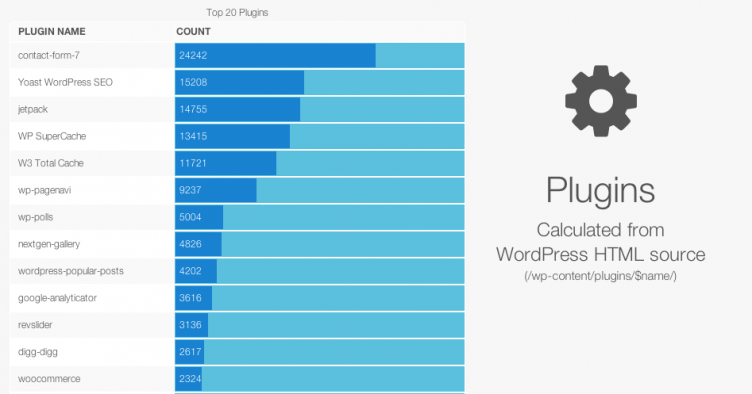 A website called Hacker Target has posted a roundup of cute graphs with usage statistics for WordPress themes, plugins, and hosting for the top 500,000 on the internet. The results are fun to look at, but you should consider them as an interesting note, with a big asterisk.
A website called Hacker Target has posted a roundup of cute graphs with usage statistics for WordPress themes, plugins, and hosting for the top 500,000 on the internet. The results are fun to look at, but you should consider them as an interesting note, with a big asterisk.
One reason for the asterisk is clear in their opening paragraph:
Results in the charts below are derived from examining the Alexa top 500K sites. WordPress sites were identified through discovery of
/wp-content/plugins/and / or/wp-content/themes/in the HTML source of the page.
As many folks will know, the existence of wp-content is not a definitive identifier for anything, as it and other directories are easy to change. So including these in the search query of the source makes it difficult to use as a reliable source.
Additionally, some of the top websites in the world utilize WordPress in the backend, but the frontend is displayed completely independently. Mashable is a good example of this. Browsing the source code of Mashable doesn’t revel WordPress at all.
Even further, many huge websites use WordPress in part of their application, but not necessarily on the home page. Big newspapers come to mind.
And finally, I think their metrics for measuring themes are the most shaky. It’s possible to be using a theme and never see the name of the parent theme. Forkable themes like Underscores are one example. But even for themes that maintain their name, it’s possible that Javascript and Stylesheets are only loaded in the child theme, and none from the parent theme are present in the source code at all. And the second most popular theme listed is “pub”, which I’m pretty sure isn’t any mass distributed theme, hinting at the flakiness of the metric.
Regarding hosting, I have a feeling it’s doing a good job of identifying the underlying hosting, but not really the “brands” we know. For instance, Unified Layer is the far-away leader in the list. But what is that? Ah, owned by EIG, the owner of Hostgator, Bluehost, and scores more. That pattern can be attributed to many of the technologies listed in the hosting section. Just because it says it runs on AWS doesn’t mean it’s not on Pagely, and because it says Rackspace doesn’t mean it’s not on Pressable, etc.
So, have fun looking at these stats. I did enjoy it. But don’t get too excited about their accuracy.

Another small thing that you don’t mention: Alexa, whilst claiming to be the ranking site for the Internet, is hardly reliable as a source for real usage, and even admits it, since there is a difference between the coverage for those sites with a paid subscription to the service, and those which use it for free.
Hey Brian,
These were fun stats, but as you implied, they should be taken with a grain of salt. Anyways, I just wanted to reach out and let you know that I included this in the WiredTree roundup of May’s best CMS content. http://www.wiredtree.com/blog/the-monthly-round-up-mays-best-web-designdevelopment-cms-and-security-content/ Thanks for linking to this.
Rachel